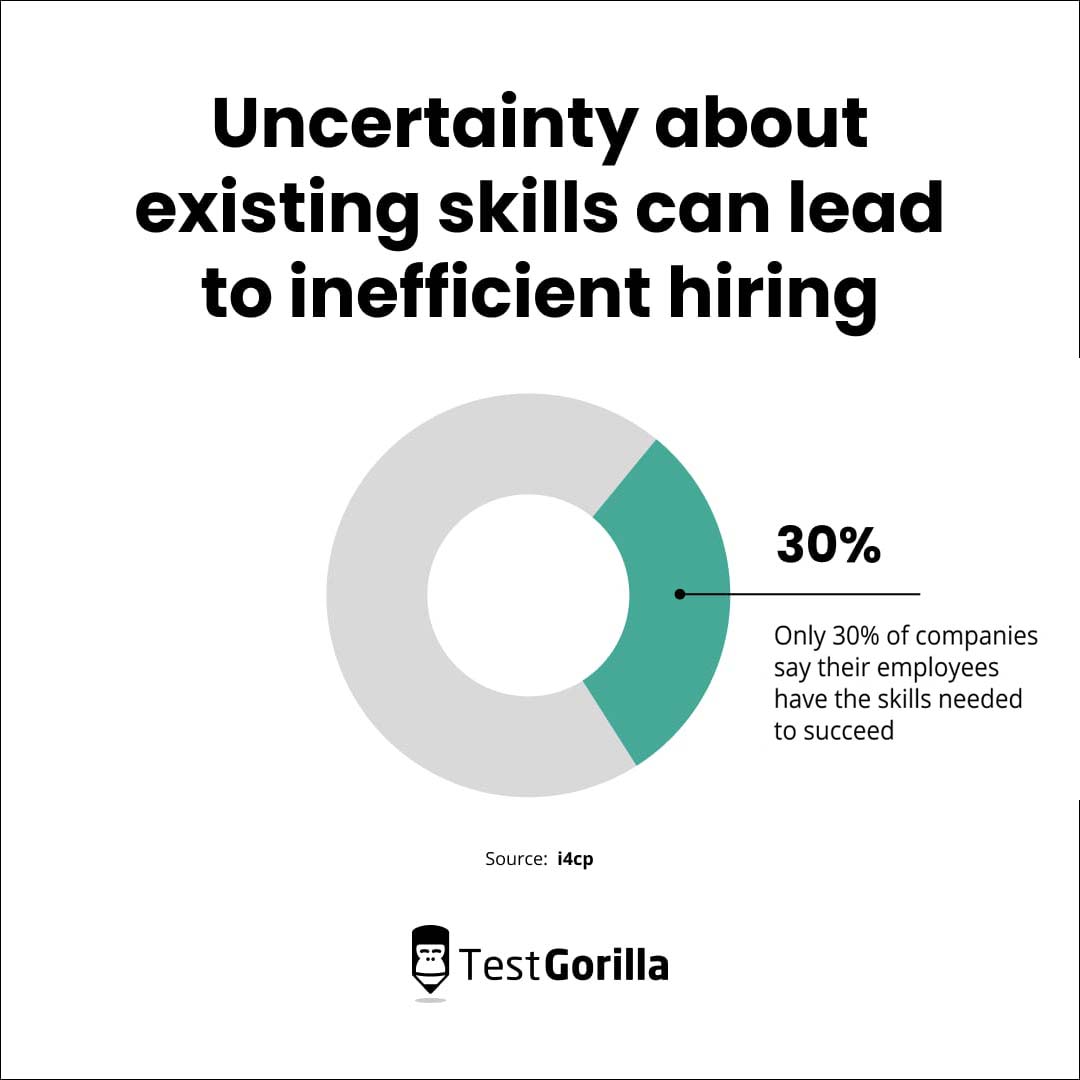Hiring efficiency: How talent assessments help streamline the recruitment process
Filling roles promptly is crucial to organizational growth and success.
But many hiring initiatives hit roadblocks like poor communication and seemingly-endless stacks of resumes, with many high performers slipping through the cracks.
Talent assessments boost hiring efficiency by quickly locating talent, reducing time-to-hire, and increasing retention.
Struggling to hire a new software engineer? Skills tests, like our Software Engineering Online test, evaluate a candidate's role-specific programming skills and only take 10 minutes to complete.
Instead of sitting through hours of interviews, talent assessments also measure candidates’ soft skills, personality types, and situational judgment.
This way, you can focus on a candidate’s ability to do the job.
In this article, we explore the common difficulties with hiring efficiency, how talent assessments boost efficiency, and the different ways to implement them into your hiring process.
Table of contents
The difficulties with hiring efficiency
Traditional hiring methods and HR business-as-usual practices aren’t cutting it in the 2020s.
Hiring managers say it takes around 11 weeks to fill a vacancy, an increase of seven weeks from 2021.
What’s slowing the process down?
Resume evaluation
Unstructured interviews
Uncertainty about existing skills
Poor communication
1. Resume evaluation
Resume evaluation is a broken process.
Most recruiters receive hundreds of resumes daily and don’t have the time, energy, or resources to advance more than a few candidates to the interview stage.
Automation, like using resume screening software, isn’t the answer, either.
Although an applicant tracking system can save recruiters time, it doesn’t offer a competitive advantage because many companies use similar keywords for talent acquisition.
A keyword-based resume screening process also eliminates top talent that, for whatever reason, did not include relevant keywords, making it harder for recruiters to find a good fit.
On the other hand, underqualified candidates can take advantage of this process by keyword-stuffing their resumes to catch recruiters’ eyes.
Resumes also reveal little information about a candidate’s skills and increase the chance of mis-hires, threatening efficiency with unnecessary financial and unseen personal costs.
2. Unstructured interviews
There’s a common misconception that a typical interview reveals a candidate’s skills, personality, and potential fit with your organization.
Interviews enable hiring managers to see what the candidate is like face-to-face, right?
Not exactly.
Many hiring processes use unstructured interviews that threaten hiring efficiency and reveal little about a candidate’s skills or abilities.
If you use unstructured interviews, you:
Ask different questions each time
Ask them in a different order each time
Ask questions that can be unrelated to the role’s responsibilities
Don’t assess a candidate’s skills
Don’t judge their answer with a standardized assessment
Don’t have clear benchmarks for good answers
Unstructured interviews are also rife with bias. Research shows that they are susceptible to bias which can lead to bad hiring decisions.[1]
In other words, companies refuse these candidates because of completely arbitrary, subjective instances that particular interviewers happened to dislike.
Rejecting candidates this way has little to do with efficient recruitment and everything to do with finding a candidate that an interviewer happens to enjoy on a superficial level.
3. Uncertainty about existing skills
Research from i4cp shows that most organizations do not know the existing skills and capabilities within their workforces.
Only 30% of companies say their employees have the skills needed to succeed in their roles.
If employers don’t know what their existing employees can or can’t accomplish, they won’t know what type of candidates to hire.
Uncertainty about employees’ skill levels makes many businesses rely on inefficient skills metrics like degrees, cover letters, and resumes.
Interviewers hope to identify a candidate who looks good on paper, even though it’s unclear if they’re right for the job.
4. Poor communication
On top of these outdated and ineffective recruitment strategies, poor communication also damages hiring efficiency and your employer brand.
Poor communication can occur:
Between members of your hiring team. Poor communication in the workplace can slow basic hiring processes like tracking applicants, scheduling interviews, and educating recruiters about what the role entails.
Between recruiters and applicants. Keeping candidates in the dark about your hiring process negatively impacts candidate experience. More than half of candidates surveyed in a 2023 CareerPlug report declined job offers because of negative hiring experiences.
Between organizations and talent pools: If you don’t clearly outline the job role, responsibilities, and required skills in your job descriptions, even the best candidates may jump ship further into the process or ignore your listing entirely.
How talent assessments help with efficient recruitment
Talent assessments help you gather objective candidate data quickly and efficiently, avoiding bottlenecks, improving the candidate experience, and putting great talent in your company faster.
They can be role-specific skills tests, personality tests, technical skills tests, situational awareness tests, or structured behavioral interviews.
Talent assessments are most effective when combined with other tests.
That’s because a successful talent assessment process relies on multi-measure tests to paint a full picture of each candidate.
In short, talent assessments are part of a holistic hiring process that considers a candidate’s professional skills, values, and worldview.
Reduce mis-hires
According to our report, the State of Skills-Based Hiring 2022, 92.7% of organizations reduced the number of candidates who were mis-hired by eliminating degree requirements in favor of skills-based recruitment metrics, like talent assessments.
Take Eva De Mol, the co-founder of CapitalT, who contributed to the report. When trying to fill an open role at her organization, she initially relied on candidates from her existing professional networks, expecting they would be highly qualified.
They weren’t.
She ended up finding an ideal candidate after evaluating them with talent assessments and receiving positive objective data about their skills and abilities without wasting time.
Talent assessments helped her dodge a mis-hire and fill her vacancy with the right candidate.
But talent assessments also help businesses address internal skills gaps. A skills gap is when a company, a team, or an individual doesn’t have every skill necessary to succeed in their role.
You can identify these gaps by conducting a skills-gap analysis.
Skills-gap talent assessment | How it works |
SWOT analysis | Strengths, weaknesses, opportunities, and threats. Map out what your company is doing well and areas for improvement. |
360 evaluation | Getting feedback on employees from their peers, managers, and customers. |
External evaluation | Hiring an external evaluator to objectively assess your skills gaps. |
Improve time-to-hire
Our report also found that 91.4% of businesses that used skills-based hiring strategies, like multi-measure talent assessments, reduced total time-to-hire.
Paul Abercrombie, the director of talent at Klaviyo, says the company abandoned its clunky manual system for skills-based talent assessments, significantly accelerating its hiring process.
And he’s not alone.
More than 60% of experts agree that talent assessments, like skills tests, are important for faster candidate screening.[2]
Let’s say you’re hiring a project manager for your software architecture firm.
Instead of wading through an ocean of qualified candidates and relying on degree requirements, you can offer candidates a role-specific talent assessment, like our Project Management test.
The test is fully remote, offered in seven languages, and should take no more than 10 minutes to complete. Test results give you insight into candidates’ skills like:
Defining, managing, and delivering high-quality project work
Estimating, running, and de-risking project schedules
Communicating effectively through all stages of a project’s life cycle.
What about their software skills or their personality style?
To cover your hiring bases, you can implement our other multi-measure talent assessments, like the Software Architect Online test or our DISC Personality test.
Increase employee retention
An efficient hiring process doesn’t just fill job openings quickly. It ensures that your new hires and existing team members want to stay and grow with your company after onboarding is over.
How? By locating, hiring, and supporting top candidates with the skills to succeed in their roles.
Implementing talent assessments is a key employee retention strategy to verify candidate abilities in specific roles so they don’t leave or fail to complete projects because they don’t have the right skills.
Increasing retention can facilitate internal mobility since your hires aren’t passive candidates for other employers.
Take call centers, for example.
Research shows that call centers have extremely high turnover rates compared with other industries (the average turnover rate is 30%-45%).[3]
High turnover rates:
Damage productivity
Overburden existing employees
Increase continual recruitment costs
Prevent managers from establishing consistent teams
Moreover, hiring the wrong candidates for call center roles can damage the customer experience and brand image.
Talent assessments avoid the consequences of high turnover by pinpointing specific candidate skills and their potential to improve an organization.
For example, our Call Center Representative test evaluates candidates' verbal communication, problem-solving, active listening, and teamwork skills.
If you want to take your talent assessment process one step further for external or internal recruitment, you can learn how to create and use your own test.
Overcome bias
Bias in your hiring process is unethical and a major sign of inefficiency that can damage your talent pool management.
Eliminating candidates based on their ethnic, social, financial, or educational backgrounds shrinks your talent pool to your organization’s detriment.
Research shows that diverse organizations are 35% more productive and make better decisions 87% of the time.[4]
Businesses with ethnic and culturally diverse leadership are more than 30% likely to outperform their industry peers.[5]
Talent assessments boost hiring efficiency by overcoming unconscious bias in the hiring process and focusing on a candidate's skills and ability to do the job.
But diversity hiring isn’t an attempt to ignore cultural differences.
It’s intentionally hiring candidates who can add to your company culture to increase innovation, eliminate groupthink, and challenge the status quo.
Our Culture Add test, for example, is a personality and culture test that assesses how a candidate’s values and behaviors help your organization thrive by improving and contributing to organizational culture.
7 tips for using talent assessments to optimize hiring efficiency
Using talent assessments is an important part of an effective recruitment and selection process.
Here are seven practical tips for implementing talent assessments:
Tip | How it works |
Use a combination of tests | Decreases bias and provides in-depth candidate information |
Use talent assessments early | Identifies skilled talent quicker, shortening time-to-hire |
Advertise them on job postings | Attracts candidates who value accurate job descriptions and want to show off their skills |
Get familiar with each test | Helps you understand what you are testing for and how to interpret the results |
Avoid AI | Decreases bias in hiring and increases diversity, creativity, and innovation |
Facilitate internal mobility | Reduces turnover and attracts talent who value learning and development opportunities |
Ask for feedback | Helps you identify the effectiveness of your talent assessment process |
Let’s examine them in more detail.
1. Use a combination of talent assessments
There are many different types of skills assessment tests for your hiring needs:
Language tests
Personality and culture tests
Programming skills tests
Role-specific tests
Situational judgment tests
It’s important to underline that talent assessments are the most effective and least biased when you use them in combination with each other.
For example, relying solely on a personality test in the hiring process can increase bias and damage hiring efficiency.
Use personality tests to give your hiring team an objective look at a candidate’s personality – not select candidates with a personality you favor.
The same applies to other talent assessments, like role-specific tests.
Using one role-specific test doesn’t increase bias in hiring, but your talent assessment process shouldn’t end there.
Remember: You improve hiring efficiency by gaining an in-depth, holistic understanding of your candidates’ skills, abilities, and potential to add to your culture.
2. Use talent assessments early on in your hiring process
When your recruitment team uses effective strategies, overall time-to-hire decreases.
Using talent assessments early in your hiring process quickly identifies which candidates have relevant skills and growth potential and which are not right for the role.
With 80% of job candidates wanting faster response times from recruiters, testing right off the bat is a great way to zero in on high performers and maintain a positive candidate experience.[6]
3. Advertise your talent assessments on your job postings
It’s important to look at your hiring process from the candidate’s perspective.
According to our above-mentioned report, more than half of job candidates prefer a hiring process with skills tests.
Communicating the value of your talent assessments clearly attracts candidates who value accuracy, objectivity, and a chance to show off their skills.
According to Nicole Roberts, the senior vice president of people at Forta, poorly crafted job postings can attract the wrong candidates, causing applicants to try to fit the mold of what they think the job is, based on the description.
It also reduces the chance of mis-hiring candidates who have the skills to do the job but are not satisfied with the responsibilities, workload, or expectations of the role.
4. Get familiar with each test
Conducting a skills-gap analysis to identify internal skills gaps and identifying the right talent pipeline are great first steps.
But before deciding which test is right for your organization, get familiar with each talent assessment.
It’s always a good idea to test the product you’re buying, which also gives you insight into how each test gathers and tracks candidate data.
TestGorilla’s Enneagram Personality test, for example, maps out nine different personality types on a nine-pointed diagram describing each type’s core beliefs, motivations, and worldviews.
Interpreting the results of a talent assessment is just as important as implementing one.
After completing the test, you’ll receive a comprehensive overview of your test results, a full breakdown of your scores, and how the candidate performed in each area.
The test results explain each personality type and its strengths, weaknesses, and behavior in personal and professional relationships. They also offer possible coaching points for management.
5. Avoid assessments that rely heavily on AI
If you’re ready to hire for skills, we do not recommend using AI-powered talent assessments.
AI platforms can introduce bias into the hiring process rather than eliminate it.
Amazon, for example, had to dismantle its AI hiring tool in 2018 because it showed bias against female candidates during recruitment.[7]
The company’s AI-powered tool gave tech job candidates scores from one to five stars and overwhelmingly awarded men more stars.
Why? The company trained its AI computer models to vet applicants by referencing patterns in resumes submitted to Amazon during a 10-year period.
Resumes are prone to bias, and most of the resumes for tech positions during that time came from men, making the model inherit that bias.
Use talent assessments that do not rely on AI to eliminate bias from your hiring process.
If you’re hiring in the tech sector, you can try one of our many different tech skills tests, like the Tableau Online test.
This test assesses candidate abilities like connecting and managing data, building visualizations and interactive dashboards, and performing advanced calculations.
6. Facilitate internal mobility
Facilitating internal mobility within your organization is key to hiring efficiency because it reduces turnover and attracts talent.
How do you facilitate internal mobility? By offering learning and development opportunities.
Multi-measure talent assessments weed out unqualified candidates, but they also help your employees achieve their professional goals and benefit your business.
When considering a new employer, 80% of job candidates look for upskilling and reskilling opportunities.[8]
That’s where professional development plans come in handy.
Talent assessments are an important part of professional development plans because they identify your employees’ existing skills and evaluate how an employee sees themselves.
Self-assessments give you and your employee insight into their opinions of themselves, their developmental progress, and the direction they would like to take within your organization.
7. Ask for feedback
Understanding the experiences of your test takers, whether they are job seekers or existing employees, gives you valuable insight into the effectiveness of your talent assessment process.
Maybe the interview questions you’re asking on your assessment are unclear, or the test is taking too long to complete.
Encouraging feedback at all levels of your organization improves your tests and benefits your business.
Beyond talent assessments: 5 tips to boost hiring efficiency
Talent assessments aren’t the only way to boost hiring efficiency; other effective recruiting strategies also exist.
Here, we discuss five of the most important ones:
Use structured interviews
Give candidates take-home assignments
Eliminate degree and experience requirements
Write clear job descriptions
Focus on recruitment efficiency metrics
1. Use structured interviews
If you choose to interview candidates, use a structured interview format.
You can use two types of structured interviews instead of the traditional unstructured interview.
1. Structured behavioral interview. Learn about candidates’ part experiences by asking for specific examples related to their behavior, abilities, and skills in certain contexts.
2. Structured situational interview. Ask candidates hypothetical questions about how they would handle certain work-related situations.
Research shows that a combination of structured interviews and talent assessment is the strongest predictor of job performance, boosting hiring efficiency and reducing turnover. [9]
2. Give candidates paid trials
Giving candidates a paid trial, like a take-home assignment, boosts hiring efficiency in three key ways.
1. It gives candidates an accurate depiction of the job. When candidates complete a paid trial, they know what type of work to expect if hired. There’s less likelihood that a new hire jumps ship because the job is different from what they expected.
2. You learn about a candidate’s role-specific abilities. When skills are involved, paid trials provide hard data about the candidate’s ability to do the job instead of taking their word for it. The chance of mis-hiring a candidate who doesn’t have the necessary skills to succeed in their role decreases.
3. It shows your investment from the beginning. Paying candidates to complete job trials shows them you are willing to put some skin in the game. Investing in candidates before you hire them is a sign of good faith and respect.
For example, if you’re hiring a graphic designer, you can give candidates a project they can complete remotely, like an email graphic or a brochure.
3. Eliminate degree and experience requirements
Degree inflation is a serious issue plaguing hiring managers and candidates alike.
Degrees do not offer any tangible information about a candidate’s skills. Instead, they increase bias and run the risk of mis-hiring.
Eliminating degree and experience requirements from your job descriptions boosts hiring efficiency because it does not screen out skilled talent based on arbitrary education qualifications.
4. Write clear job descriptions
Writing great job descriptions also improves hiring efficiency. You only have a short amount of time to catch the candidates’ attention, present an accurate depiction of the role, and list relevant skills requirements.
Your job descriptions should outline the knowledge, skills, or competencies required.
They should also detail the working conditions and touch on company benefits and perks.
What type of environment will your candidates be working in? What is the core of your organization’s culture? What learning and development opportunities are available to them?
Make sure to write clear job descriptions that address these points.
5. Focus on recruitment efficiency metrics
Recruitment efficiency metrics help organizations decide how much time and money to spend on specific recruiting processes and calculate conversion rates at each level of the hiring funnel.
Data-driven recruitment helps you make strategic decisions about your recruitment efforts and bring in quality candidates.
The seven recruitment efficiency metrics to focus on are:
Recruitment efficiency metric | What it measures |
Source of hire | Shows what percentage of your overall hires came from each recruiting channel or source |
Application completion rate | Shows you how many candidates completed your application form |
Turnover rate | Measures the rate at which employees leave your organization within a certain period |
Offer acceptance rate | Shows the percentage of candidates who accepted your job offers and how attractive and competitive those offers are |
Measures the value a new hire brings to your organization | |
Applicant to interview | Measures how many of your candidates you moved to the interview phase |
Interview to offer | Shows the number of job offers extended relative to the number of applicants who participated in job interviews |
Maximize hiring efficiency with talent assessments
Incorporating talent assessments into your recruitment process improves hiring efficiency by reducing mis-hires, improving time-to-hire, increasing retention, and mitigating unconscious bias.
Talent assessments are data-backed, multi-measure testing tools that you should combine to get the best results.
It’s important to advertise your talent assessments to potential candidates in your talent pool because most people want to show their skills and get a sense of what the job is like.
Talent assessments are also a helpful tool for high volume hiring. Putting dozens of applicants through the traditional resume-cover letter-interview process can feel unbearable to all parties involved.
If you want to learn how to improve recruiting efficiency and discover more about how talent assessments improve recruiting efficiency, check out our test library.
Sources
Aamodt, Michael G. (May 2006). “Do Structured interviews eliminate bias? A meta-analytic comparison of structured and unstructured interviews”. Society for Industrial-Organizational Psychology. Retrieved July 23, 2023. https://www.researchgate.net/publication/308753199_Do_structured_interviews_eliminate_bias_A_meta-analytic_comparison_of_structured_and_unstructured_interviews
Masselos, Julia. (July 3, 2023). “21 Recruitment Industry Trends for 2021”. Toggl blog. Retrieved July 23, 2023. https://toggl.com/blog/recruitment-industry-trends-2021
“5 Reasons for Call Center Turnover and What to Do About It?”. (May 1, 2023). CallCenter Studios. Retrieved July 23, 2023. https://callcenterstudio.com/blog/high-call-center-turnover-rate-and-how-reduce-it/
“Why Is Diversity and Inclusion Important?”. LinkedIn Learning. Retrieved July 23, 2023. https://learning.linkedin.com/resources/learning-culture/diversity-workplace-statistics-dei-importance
Romeo, Regina W. (2023). “How Diversity Improves Organizational Performance”. CPS HR Consulting. Retrieved July 23, 2023. https://www.cpshr.us/resources/how-diversity-improves-organizational-performance
Golden, Ryan. (November 1, 2022). “Need for speed: 80% of candidates want faster response times from recruiters”. HR Dive. Retrieved July 23, 2023. https://www.hrdive.com/news/job-candidates-want-faster-response-times-from-recruiters-ghosting/635448/
Weissmann, Jordan. (October 10, 2018). “Amazon Created a Hiring Tool Using A.I. It Immediately Started Discriminating Against Women”. Slate. Retrieved July 23, 2023. https://slate.com/business/2018/10/amazon-artificial-intelligence-hiring-discrimination-women.html
“Learning And Development: The Key To Employee Retention”. (October 14, 2022). LinkedIn. Retrieved July 23, 2023. https://www.linkedin.com/pulse/learning-development-key-employee-retention-intellezy/
Schmidt, Frank L. (October 2016). “The Validity and Utility of Selection Methods in Personnel Psychology: Practical and Theoretical Implications of 100 Years…”. University of Iowa. Retrieved July 23, 2023. https://www.researchgate.net/publication/309203898_The_Validity_and_Utility_of_Selection_Methods_in_Personnel_Psychology_Practical_and_Theoretical_Implications_of_100_Years_of_Research_Findings
Related posts
You've scrolled this far
Why not try TestGorilla for free, and see what happens when you put skills first.
Latest posts
The best insights on HR and recruitment, delivered to your inbox.
Biweekly updates. No spam. Unsubscribe any time.

Skills tests to hire the best
Our screening tests identify the best candidates and make your hiring decisions faster, easier, and bias-free.
Free resources
A step-by-step blueprint that will help you maximize the benefits of skills-based hiring from faster time-to-hire to improved employee retention.
With our onboarding email templates, you'll reduce first-day jitters, boost confidence, and create a seamless experience for your new hires.
This handbook provides actionable insights, use cases, data, and tools to help you implement skills-based hiring for optimal success
A comprehensive guide packed with detailed strategies, timelines, and best practices — to help you build a seamless onboarding plan.
This in-depth guide includes tools, metrics, and a step-by-step plan for tracking and boosting your recruitment ROI.
Get all the essentials of HR in one place! This cheat sheet covers KPIs, roles, talent acquisition, compliance, performance management, and more to boost your HR expertise.
Onboarding employees can be a challenge. This checklist provides detailed best practices broken down by days, weeks, and months after joining.
Track all the critical calculations that contribute to your recruitment process and find out how to optimize them with this cheat sheet.
















